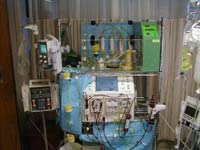UNC to test new assist device for failed livers

Prospects for surviving acute liver failure are very slim, and statistics place mortality as high as 90 percent. A liver transplant may be the only alternative before fatal complications set in, yet not enough donor organs are available to meet the demand.
But a new bio-artificial technology about to undergo clinical tests at the University of North Carolina at Chapel Hill and several other centers nationally may help extend the lives of those awaiting a donor liver and may even allow the damaged liver to heal itself completely.
Known by its acronym ELAD, the extracorporeal liver assist device is the first such technology to contain functioning human hepatocytes, liver cells that help sustain and support the work of the patient’s damaged and failed organ. Other liver assist systems use hepatocytes from pigs.
The new device is a closed system to which patients are tethered via a catheter inserted into a vein in the neck. After the blood is initially filtered, the remaining plasma goes through cartridges in the ELAD where the human hepatocytes help fulfill much of the liver’s 100 or so crucial functions, such as energy storage and regulation, bile production, blood detoxification, production of clotting factors and many essential proteins. The filtered blood and ELAD-treated plasma are returned to the patient.
Dr. Roshan Shrestha, associate professor of medicine and medical director of the liver transplantation program at UNC, said ELAD could provide two major benefits.
“This device could serve as a bridge to successful transplantation, helping to sustain patients awaiting a donor organ.”
It also may enable complete recovery, he added.
“A remarkable feature of the liver is its capacity to regenerate. If we can sustain acute liver failure patients early on, right from the beginning, they may not need transplantation and may recover without any significant liver problems, including chronic liver disease.”
Shrestha, principal investigator for the UNC study site, said a first-phase clinical trial conducted in the United States and Great Britain during 1999 and 2000 showed promising results. In that study, sponsored by ELAD maker Vitagen Inc., 11 of 12 (91.6 percent) of patients who had been randomized to receive treatment with the new device achieved either a successful bridge to transplantation or full recovery. In a control group of patients receiving standard care, three of seven (42 percent) achieved those benefits.
In an analysis of overall results in 25 patients, including those not listed for liver transplantation, 13 of 16 (81 percent) improved on the device, compared to only five of nine (51 percent) in the control group.
Shrestha said the U.S. Food and Drug Administration was sufficiently pleased with the results to give its nod to a second-phase trial, also sponsored by Vitagen. Safety and effectiveness, including survival at 30 days, is the main endpoint, Shrestha said.
“The primary objective is to evaluate the safety, efficacy and tolerability of the ELAD system in patients with acute hepatic [liver] failure. Our secondary objective is to evaluate the study protocol with respect to patient inclusion and exclusion criteria and to study the system’s performance with regard to endpoints.” Total enrollment for this trial is between 30 and 40 patients. A larger third-phase trial may follow, with an enrollment of at least 200 people with acute liver failure.
“Currently, we don’t have very good therapies for patients with acute liver failure. That’s why we’re hoping that the new technology will make a big difference,” Shrestha said. “The bottom line is to save lives.”
Note: Contact Shrestha at (919) 843-9459 or (919) 966-2516 (choose option “O”), or r_shrestha@med.unc.edu.
School of Medicine contact: Les Lang, (919) 843-9687 or llang@med.unc.edu
Media Contact
More Information:
http://www.med.unc.edu/All latest news from the category: Health and Medicine
This subject area encompasses research and studies in the field of human medicine.
Among the wide-ranging list of topics covered here are anesthesiology, anatomy, surgery, human genetics, hygiene and environmental medicine, internal medicine, neurology, pharmacology, physiology, urology and dental medicine.
Newest articles

Superradiant atoms could push the boundaries of how precisely time can be measured
Superradiant atoms can help us measure time more precisely than ever. In a new study, researchers from the University of Copenhagen present a new method for measuring the time interval,…

Ion thermoelectric conversion devices for near room temperature
The electrode sheet of the thermoelectric device consists of ionic hydrogel, which is sandwiched between the electrodes to form, and the Prussian blue on the electrode undergoes a redox reaction…

Zap Energy achieves 37-million-degree temperatures in a compact device
New publication reports record electron temperatures for a small-scale, sheared-flow-stabilized Z-pinch fusion device. In the nine decades since humans first produced fusion reactions, only a few fusion technologies have demonstrated…





















